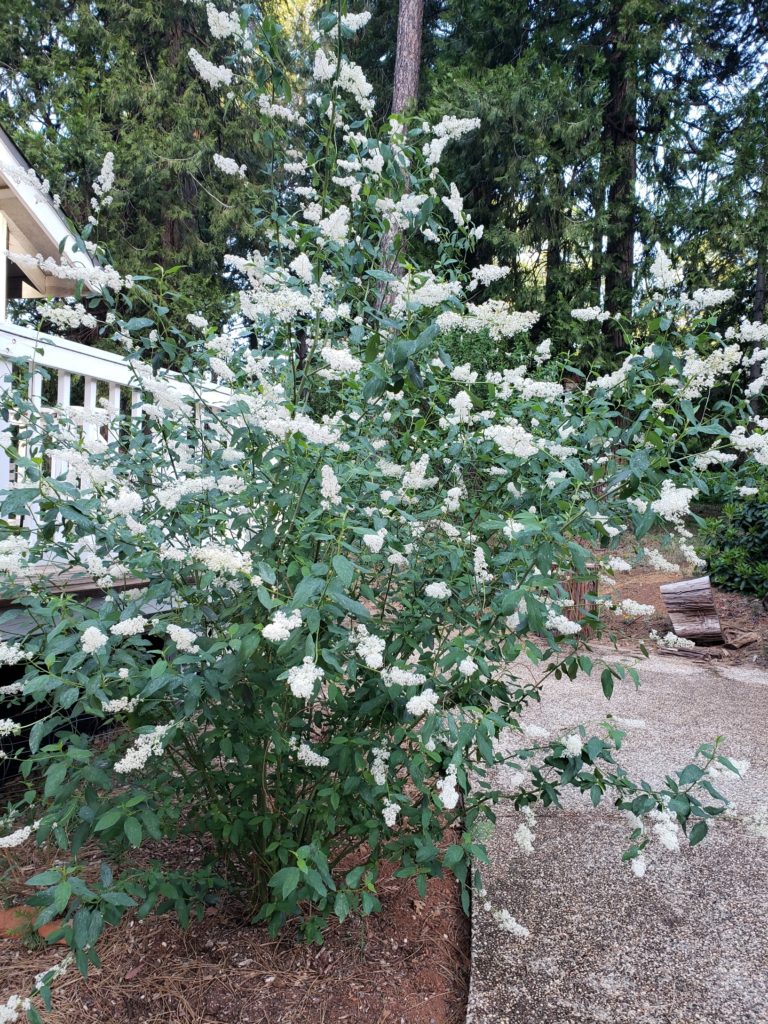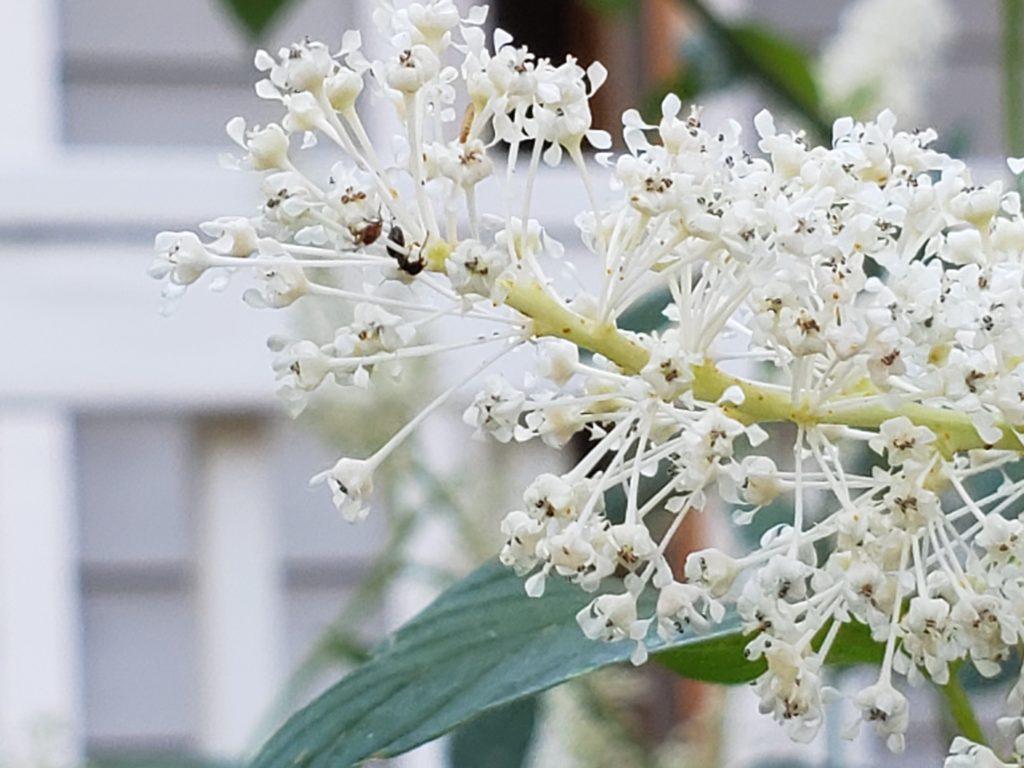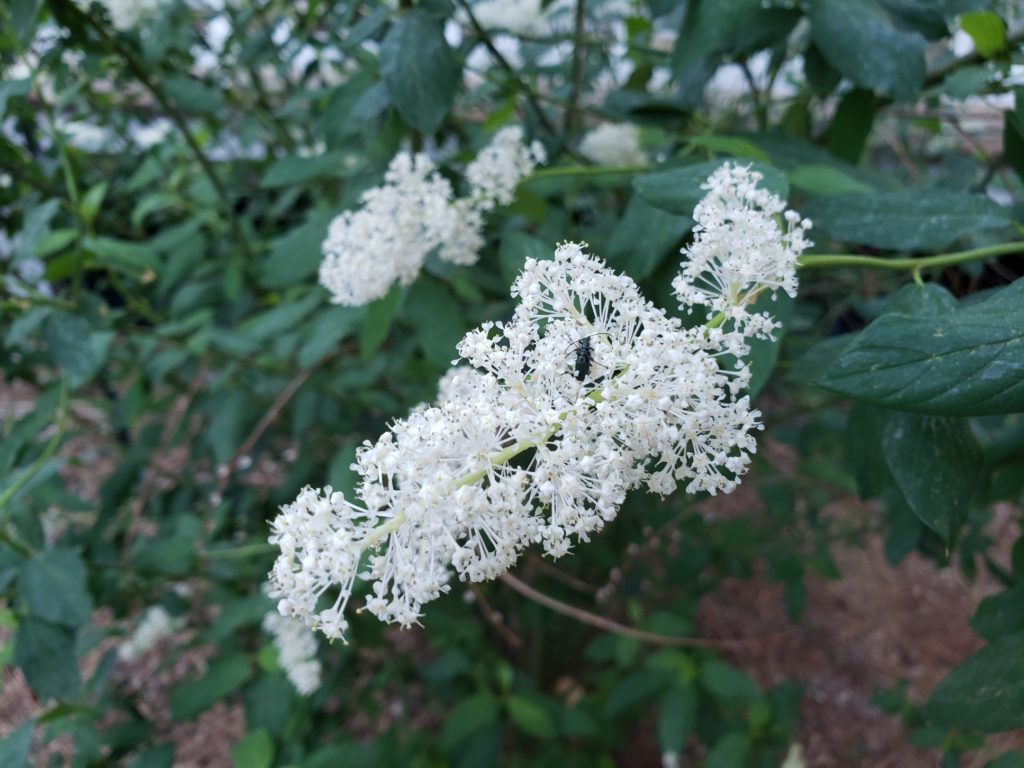Have you noticed the California lilacs blooming this spring? Many are a beautiful blue, and some are white. The white ones that are abundant around here are still blooming and stand out. Erect, fountain-shaped shrubs with lilac-like clusters of white fragrant flowers, these shrubs are an asset to our botanical community and offer big benefits to our home landscapes, too.
The California lilacs are of the Ceanothus genus. Many of the blue Ceanothus are used in low-water landscapes. The white flowering type that’s just wrapping up its bloom is Ceanothus integerrimus, commonly called Deerbrush. (See Calscape.org for more.)
The flowers are fragrant, borne in lilac-like clusters of tiny flowers. These tiny flowers feed insects—good insects. They bloom early in the season feed many of the insects that are beneficial to the rest of the landscape. The adults get their food from pollen and nectar so they can mate and lay their eggs. It’s the larvae of the “good” bugs that eat or parasitize the “bad” bugs—the ones that bother our gardens.
Plus, insects feed birds, especially when birds are rearing their young. Even hummingbirds eat insects, not only nectar. Baby hummingbirds need to have insects comprise about 30% of their diet. They all need insects and caterpillars for protein to build their bodies.
All Ceanothus flower early, the blue flowering ones are earliest. When you see a Ceanothus flower cluster, go up close to it and watch for a little while. They simply buzz with insect activity! This includes many types of bees.
I have Deerbrush outside my deck and each flower cluster is so busy with such a variety of insects. I watch a variety of beetles, lacewings, bumble bees, hover flies, and so many insects I’ve never seen before.
There are even tiny quiet ones that hover and flit about, barely noticed by most casual observers. These tend to be the most voracious pest-fighting insects we have.
And, Ceanothus supports pollinators early in the season providing food for the native bees emerging from their nests, like bumble bees.
Ceanothus foliage is food for the caterpillars of Pale Tiger Swallowtail and the California Tortoiseshell butterfly, keeping them around in good numbers.

Deerbrush is very easy to grow
It’s a native that is widespread through much of California, except for the vast central valley, and is adaptable to many soils, especially the red clay so common around here. They take full sun to part shade.
And it needs no water! If you plant this plant, it only needs water the first year, maybe some the second, to get its roots established. But then it’s good on its own.
There is a myth that California lilacs are short-lived. That’s because they are typically used in landscape situations where they are over watered and planted with soil amendments. The drought tolerant California natives don’t need these and grow fast and die young with that treatment.
Another myth is that they are eaten by deer, but that’s only more likely when the plants are over watered and fertilized.
According to Las Palitas Nursery, if you have a high deer population, choose only Ceanothus species native to your area, and don’t water them.
They’re good for the soil, too
California lilacs help improve the soil. Their roots host actinomycete bacteria that take nitrogen from the atmosphere and fix it into the soil, thus enriching it. That’s one reason fertilizing is not needed. This is like what legumes do to add nitrogen to the soil.
Deerbrush is often used for site regeneration and it’s a great bank stabilizer.
Where do we see the plant?
Deerbrush is found throughout much of California, in mountain ranges along the coast and through much of the western slope of the Sierras. In our area it is at the edge of the Ponderosa Pine plant community and found on dry slopes.
It has green whip-like branches when young, but matures with a thin gray bark. There are some local women who use the young whips in beautiful basket weaving.
In our area they are mostly deciduous, but in other areas they may be evergreen.
There are a lot of them around and they really stand out when they’re in full bloom.
If you have some of these plants, keep them and leave them to their own devices. If you want to plant some, there are a few nurseries you can get them from, see Calscape.org for the list, or Google it, and a few more nurseries show up to order from.
Deerbrush hosts several butterflies, feeds numerous good insects, needs no water and no care from us. And they’re pretty.


